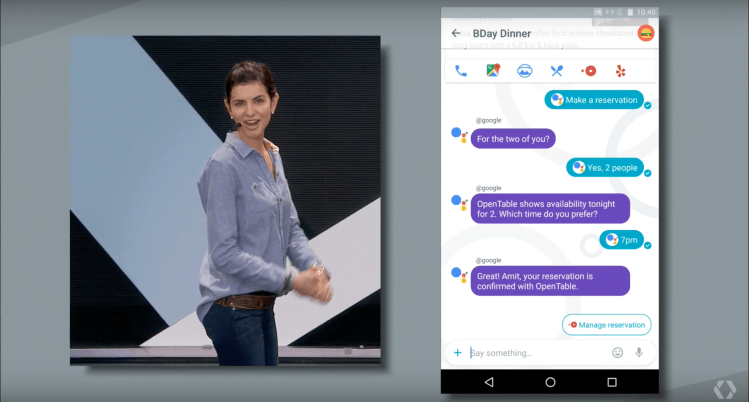Back in 1966, a decade before Apple introduced its first computer, Joseph Weizenbaum was hard at work in his lab at MIT putting the final touches on ELIZA, an early computer program to simulate human conversation.
ELIZA worked by implementing simple pattern matching, recognizing key phrases in a user’s input, then outputting preprogrammed, human-like responses. It’s not unlike the way chatbots work today, as it happens.
The technology revolution Weizenbaum helped spark 50 years ago is finally catching fire, as new developments in artificial intelligence and natural language processing have launched chatbots into the mainstream. Facebook, Kik, and other companies whose messaging platforms host bots offer businesses a way to reach out and interact with massive pools of active users.
Facebook has the largest, most engaged community in the world — what brand wouldn’t want access to Messenger’s 1 billion active users? In addition to Facebook, a variety of consumer and enterprise messaging platforms offer businesses the opportunity to create bots that serve as brand concierges, instantly connecting users with information they want and then helping them act on that information.
Bots represent an appealing business opportunity: In 2015, the global chatbot market was valued at $88.3 million, and it is expected to follow a growth path similar to that of the app economy, which reached billions of dollars annually in just a few years.
Messaging war
The battle for market share among these platforms has been dubbed the “messaging war.” The phrase makes for catchy headlines, but since it’s still early days for bots and messaging platforms, there is a wide disparity in how the most important players are approaching bot development. In other words, the “war” has begun before the battling platforms are even ready to face off.
As with many of the emerging technologies that have come before bots, we, as an industry, along with businesses that experiment with bots, need more time to determine what works and what doesn’t. At that point, the chasm will narrow, and, rather than having a war to be won or lost, we’ll end up with another way for brands to engage customers — ultimately delivering a win for everyone.
The bot platform landscape
After chatbot announcements from Google and Facebook this spring, Apple was expected to follow suit at WWDC. So it was surprising to some when Apple announced it would be taking a different approach, opening up Apple Messages to third-party app makers, as it did a year earlier with Apple TV.
Functionally, an app is not that different from a bot. They both consist of code and logic. The main distinction is the user’s mode of interaction, which is among a number of factors brands should consider when deciding whether to build a bot and/or an app.
Google Allo’s resident bot, the Google assistant, is always active and analyzing your conversations to better anticipate your needs when you activate it. This is quite different from Facebook Messenger, which hosts third-party bots used for a specific purpose or interaction and relies on users to initiate the conversation. Apple, meanwhile, offers brands the opportunity to create full-fledged apps that are an extension of its Messages app and, as a result, can potentially offer richer, more immersive experiences than other bots can.
When form and function converge
Because the key players in bot platforms each take a different approach, businesses are in “bot learning mode,” assessing the platforms and looking to developers to help determine which approach will help them deepen customer engagement and offer the best user experience. Over time, we expect that the approaches will converge.
All technologies naturally evolve as uptake increases and the human problems they solve become more defined. When smartphones became widely accessible, each mobile OS had different features to offer and different benefits depending on the use cases. Fast forward about 10 years. From a usability standpoint, Android OS and iOS have few truly unique features to attract users. In fact, the choice between devices and operating systems is increasingly arbitrary, ultimately coming down to brand allegiance, switching costs, demographics, and other external factors.
Bots face a similar future. We can theorize all we want about which strategy will win the messaging war by attracting the most brands, developers, and users. But there won’t necessarily be a single victor. Rather, there will be an evolution and a convergence of form and function as brands develop apps or bots that provide excellent user experiences on whichever platform best serves their audience.
And the winner is…
Brands that already have full-fledged apps and responsive websites can take advantage of bots’ ability to act as concierges, handling basic tasks and micro-interactions for users and then gracefully connecting users with apps or websites, as appropriate, for a more involved experience.
To that end, people are talking a lot about which bot platform to use. It may not matter too much. You can bet that the version 1 bot you release today will look different from version 2 and then version 3.
At the same time, messaging platforms are likely to evolve to the extent that their distinctions fade away and they become front-end user interfaces that allow your audience to interact with your company and use its services, deepening their loyalty along the way.
To prepare for a platform-agnostic future, it’s smart to do what you can to develop apps and bots that can evolve as the technology matures and users’ expectations increase. Brand innovators will lead the way by trying different approaches to see what resonates most with customers. Ultimately, the real winners of the messaging war should be customers, which represents a win for businesses, too.


